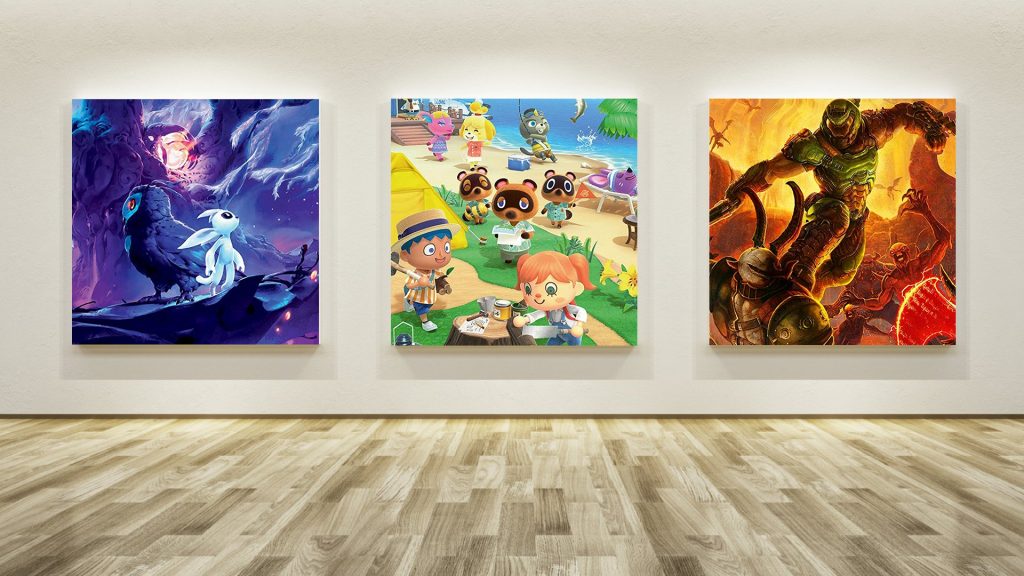Video Gamer is reader-supported. When you buy through links on our site, we may earn an affiliate commission. Prices subject to change. Learn more
Each month, we invite élite art critic Braithwaite Merriweather to appraise the box art of the latest game releases. In between his time spent wandering the corridors of culture, Merriweather writes on a freelance basis for various publications, including Snitters and Nuneaton à la Carte. If you are unaware of his prowess, rest assured; he’s on a crusade to educate the unwashed. Put simply, he’s a man that needs no introduction.
Well, to the surprise of no one, my lecture, last month, at the Centre Pompidou was misunderstood. My attempts to argue the case for a permanent game box art exhibition fell on deaf ears—or, at least, ears clogged with cultural ignorance. The murmurs that shuffled around the room reminded me of the atmosphere outside the Musée d’Orsay back in 2003, when I attempted to showcase a small offering from my own private collection of box art to what I thought was going to be a newly adoring public. They seemed not to be moved by the likes of “XIII” and “Max Payne 2: The Fall of Max Payne”—both of which were positively Warhollian in their 20th Century charms. Instead, representatives from the museum asked that I move from the premises. Dullards. Well, times have changed: I am now inside the walls of these decrepit institutions, but I have not yet breached the perimeter of mainstream artistic acceptance. It is with a slightly heavy yet determined heart, that I look to this month’s crop of box art!
Doom Eternal

It is always heartening to see a spirited depiction of Hell. And doubly heartening to see an artist hark back to Hieronymous Bosch! Gazing at this piece, titled “Doom Eternal,” I find myself helplessly cast upon a tide of modern worry. For this figure at the centre of the piece, this expressive slab of testosterone-pumped meat, hell is evidently germs. Why else would he plug his head into a helmet of such thick metal—breathing grill clamped over his mouth—and wade righteously into a swath of sickly demons? (I am considering similar measures for my trips to the local galleries, at the moment; the essentials for a box art critic, after all, are not food or supplies but sustenance of the soul!) In any case, this work has delighted me not only for its timeliness but for its timelessness. After all, visions of Hell have been manna from Heaven for artists since time immemorial.
Bosch’s “The Garden of Earthly Delights” (1490–1510) is, of course, the work from which “Doom Eternal” (which is, incidentally, an apt descriptor for my marriage, and would serve as a sobering warning for her new fiancé) takes its cue—specifically the panel on the right. I feel a compulsion to admire any artist who is willing to invoke Bosch, given that they are eternally doomed to fail to live up to such lofty standards; still, despite the near-neanderthal lack of complexity in this work, I am plunged into a pit of praise from which I cannot possibly clamber! It is Bosch for adolescents, Bosch for those who bang their heads to the sludgy rhythms of heavy metal, and, most reassuringly, Bosch for those who were starting to fear that the influence of Bosch is depleting in the modern video game box art scene.
Ori and the Will of the Wisps

This work, “Ori and the Will of the Wisps,” has the quality of iridescent algae: it somehow inhabits the form of a natural spectacle, but it has a garish tacky quality, like something from the squalling isles of a toy shop—glow-in-the-dark slime or some other nauseating phenomenon. I have a feeling that this artist, who has delivered his message via a soapy bathful of purple, means to communicate the idea of the idyllic. Even more than that: the Heavenly! The reason I say this is that I can’t shake the aw-shucks, wide-eyed religious odour of Randy Burns, whose work “Light From Heaven” seemed to operate on the notion that God’s garden lay afloat on a sea of prune juice, and that the land below, as if in need of digestive aid, would wait with open mouth, ready to lap up the divine rainfall.
The irony of this work is that, especially taken with “Doom Eternal,” it forms a depiction of Hell, not Heaven. This Hell has surely been devised as a form of personal damnation for me, given that I can’t bear the gormless worship nature, especially when it’s nature pumped up with zany colours and strewn with creatures—among them some form of glowing, mad-eared imp—that would be more at home in the literature that lines the shelves of your local Games Workshop. The elusive difficulty with homage is choosing to whom it should be paid, and what blesses one artist blights another. I am not sure what’s worse: demonstrating no appreciation for art in your art, or demonstrating bad taste. If it’s between Burns and Bosch, there is no contest, I’m afraid.
Animal Crossing: New Horizons

And now we have a triptych. This work is a menagerie of grinning horrors. Raccoons, smiling moron dolls, and, in the background, what looks like a gaggle of piñatas, clearly unaware that they will, at some point, be beaten and burst open at a child’s birthday party. That day cannot come soon enough. The artist behind this work (Satan presumably), “Animal Crossing: New Horizons,” has chosen to depict a beach—that most hoary of paradisiacal clichés. That this could be anyone’s idea of Heaven—a holiday with the jumbled and joyless contents of a child’s toy box—is simply depressing. How ironic that the two works of this week’s crop that tried to capture heaven have wound up realising the opposite, and that the one that achieved what it honestly set out to do—and thus elevated me to heavenly enjoyment—was a full-on fire and brimstone affair.
